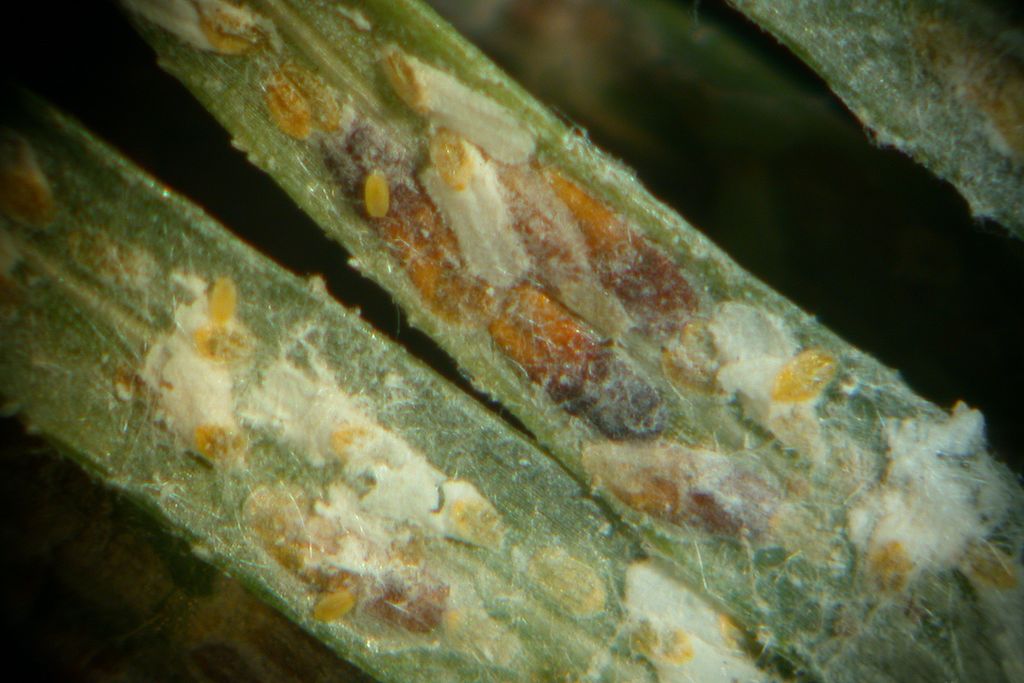Introduction
Fiorinia externa, also referred to as elongate hemlock scale or fiorina scale, is an insect native to Japan that infests eastern hemlock, northern Japanese hemlock, Carolina hemlock, fir, and spruce. Elongate hemlock scale may also be observed on cedar, Douglas-fir, pine, and yew, which tend to grow adjacent to infested hemlocks. Elongate hemlock scale has become a problem in North America, where it sometimes occurs with two other exotic pests: the circular hemlock scale Nuculapsis tsugae, and the hemlock wooly adelgid Adelges tsugae. Mixed infestations of scale insects and adelgids can cause hemlocks and other affected plants to decline rapidly.
Distribution & Habitat
In the United States, elongate hemlock scale was first discovered in Queens, NY. It has since migrated south, appearing in states from southern New England to Virginia, and west to Ohio.
Hosts
Elongate hemlock scale develops and reproduces on forty three plant species, representing seven genera of native and exotic conifers, including fourteen species that are native to the United States. Though hemlocks are common hosts, spruce and fir tend to be more susceptible to infestation.
Description
Adult females are small, and soft-bodied. When fully developed, they reach around 2mm in diameter. Females are yellow, and lack appendages or wings. They remain stationary, enclosed in a yellow or brown translucent cover. Adult males are light brown, with delicate wings and legs that distinguish them from females. They are smaller than females, growing to 1.5mm. Crawlers are first-stage nymphs that hatch from translucent eggs within the female cover. They are yellow, and soft-bodied, with tiny legs. Second stage nymphs are enclosed in an oval, amber-colored cover. They are soft-bodied, and sedentary. Nymphs vary in size, ranging from 0.1mm to 1.0mm. As the crawlers become settled, they produce waxy secretions that rapidly accumulate, building into a mass of tangled strands. If these waxy strands are created in abundance, the lower surface of infested needles may assume a white appearance.
Life Cycle
Elongate hemlock scale completes one generation each year in the Northeastern states. The insect completes two generations each year in the southern and mid-Atlantic states. Crawlers appear throughout late spring and early summer. Crawlers are the only stage in the insect’s life cycle capable of establishing new infestations. They are dispersed by the wind, or on the feet and plumage of birds.
Females progress through three stages of development, or instars, while males progress through five. Within a few days of hatching, crawlers settle beneath the waxy cuticle on the lower surface of young hemlock needles, whereupon they begin to feed. First instar nymphs secrete covers around themselves as they grow. Over time, they molt, and develop into second instar nymphs. During this period, nymphs continue to feed, and establish their covers. Second instar females eventually cease feeding, and molt into adults. Second instar males molt into a prepupa, and weave a silken cocoon that they pupate in before emerging as adults.
Adult males navigate to the sessile females, where they mate. Males die shortly thereafter. Fertilized females will generally overwinter. In early spring, females deposit around twenty eggs within their waxy covers. As the crawlers hatch, they leave the cover, parting through a small opening at the end of the enclosure. Upon emerging, crawlers migrate to nearby needles, where they feed for three to four weeks before molting into second instar nymphs. Crawlers reach maturity four weeks later.
Effects on Hemlock
Elongate hemlock scale populations typically build slowly on healthy trees. They accumulate more rapidly on stressed, or wounded trees. As the scale feeds, it causes foliage to turn yellow, and drop prematurely. Dieback of major limbs may occur, progressing upwards through the tree. Dieback generally occurs when populations exceed more than ten individuals per needle. Severe infestations can decimate trees, with many retaining only a sparse amount of foliage at the top of the crown. Successive defoliations over several years can contribute to a general decline in tree vigor. Some trees may succumb to the infestation, eventually failing. Weakened trees are more susceptible to secondary pests, such as hemlock borer, hemlock wooly adelgid, and Armillaria root rot. Outbreaks often intensify following infestations from secondary pests, drought, and other stresses.
Management
- To discourage the accumulation of scale populations, maintain tree vigor through sound cultural practices.
- Hemlocks have shallow root systems, which renders them susceptible to drought stress. As such, ensure that hemlocks and other plants are sufficiently watered, especially during dry periods.
- Avoid excessive applications of nitrogen fertilizer, and insecticides. These chemicals can contribute to increases in scale populations. Nitrogen enhances the survival, and development of the scale, resulting in dense scale populations on fertilized trees. Inadequate, or improper insecticide applications can eliminate the scale’s natural predators, leading to a resurgence in scale populations.
- Horticultural oil can be applied to ornamental plantings during early spring, when trees are dormant. A second application should be made during the growing season. This will help limit scale population density.
- Aspidiotiphagus citrinus, an aphelid parasitoid, eradicates more than 90 percent of each generation of elongate hemlock scale in Japan.
- A few coccinellid beetles, the twice-stabbed ladybird, Chilocorus stigma, and Microweisea misella prey on the scale in North America, though their impact is not severe enough to significantly alter scale populations.
- In forests, declining hemlocks should be salvaged to prevent the accumulation and spread of scale populations.
Photo courtesy of Eric R. Day, Virginia Polytechnic Institute and State University / © Bugwood.org / CC-BY-3.0-US


